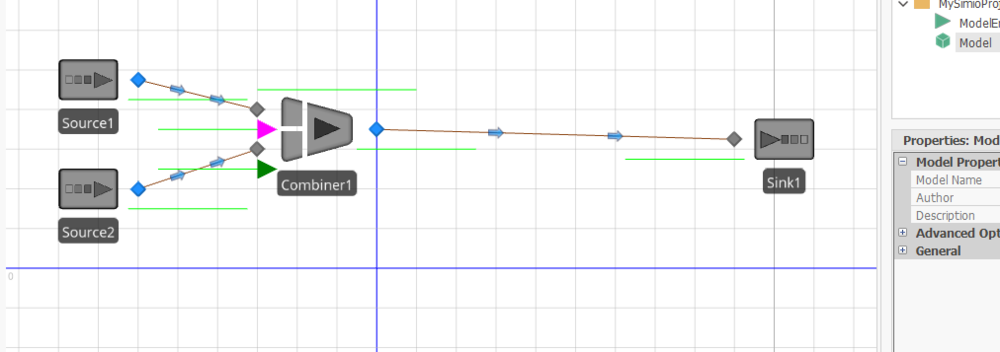Search the Community
Showing results for 'processing contents'.
-
Waiting on the path if there is no seat in input buffer
Sea Jung replied to Sea Jung's topic in SI General Discussions
This model has property that can not be accessed by me .. Server -> Other processing option -> ResourceEfficiencyRule -> Minimum Is this property for Enterprise version? -

Waiting on the path if there is no seat in input buffer
asneath replied to Sea Jung's topic in SI General Discussions
I noticed that the Source is not making just two entities, as you stated, it is actually making several as governed by your Interarrival Time. But since you have Output@Source1 (TransferNode) Blocked Destination Rule set to 'Select Available Only', all entities created after the first two are waiting until one of the Servers has finished processing. You will notice that once Server1 has finished processing, an entity is released from the Source (since its destination has been assigned). I would recommend exploring this further by enabling 'Model Trace', from the Run Ribbon, to see what is happening behind the scenes. Happy modeling! -

Off Shift Rule Secondary Resources
asneath replied to james.waller's topic in SI General Discussions
Double check that each Resource is hooked to the correct Work Schedule, and that you have the intended Day Pattern inputs for Mon - Sun in your Work Schedule(s). It sounds like you might need a separate (two total) Work Schedule for each group of 5 Resources. I would also recommend visually verifying that the Resources go OffShift (turn white) at the intended times. Other than that just make sure that the Off Shift Rule, in the Server's Secondary Resources, is also set to 'Suspend Processing'. Another way to check that the Server has suspended processing is to put some Dynamic Label Text on the Entity like 'ModelEntity.ID' so you can see exactly which Entity is in the Processing.Contents queue of the Server before and after the shift change. It should be the same one! Happy modeling! -
Off Shift Rule Secondary Resources
james.waller replied to james.waller's topic in SI General Discussions
Additional Information: In the work schedule only some of the resources are going off shift while some are staying on (in this case there are 10 resources scheduled for the shift but 5 take the first lunch break from 1130-1200 while the other 5 resources take a lunch from 1200-1230). How can I suspend processing just for the partial amount of the objects in the shift that own the 5 resources that are "taking lunch"? -
Hello, I have selected Suspend Processing in the Off Shift Rule portion of my server modules but when I use a Status Label to indicate the Resource.Capacity.Utilized / Resource.Capacity, it appears as though the resources are not going off shift until after processing the entity in the server calling on the secondary resource. What else do I need to do? I'd like for the Resource to go off shift (and not finish the process) according to the Work Schedule assigned to it and then pick back up the processing of the entity when it gets back on shift. I've looked into several other posts but they seem to be outdated. Thanks!
-
you could use a Combiner object to represent the assy station. and on the combiner's After Processing Add-on trigger , you create a processes like below..
-
The Server Initial Capacity property sets the capacity of the processing station within the Server. Regardless of the Initial Capacity value, each Server Object is regarded as a single Resource in terms of the Results provided by the simulation. This is a long way of saying that, if you want to analyze each firm separately, you will need a separate Server for each one or a pool of Secondary Resources like you had mentioned. Happy modeling!
-
I am working on a simulation of a number of firms processing raw products. If I represent the firms as resources in a server -so that the server capacity represents the number of firms, how could I identify which resource/firm processed a certain batch of products? Can this be done with a server having a capacity of its own, or should I use a pool of (secondary) resources with id labels so I can use that id to label the product batch?
-
Hello, If I have created a list state variable (The list just contains each day of the week. ie: "Sunday", "Monday", "Tuesday", etc...) and I want to assign a new value in a state assignment of the facility to a particular day within the list state variable how can I do this? It seems like I can only reference the List State Variable as a whole but I don't know how to assign values to the contents of the variable.... Thanks!
-
It is possible. There's several ways to solve this. It is just a matter of model designing. Some tips: 1. You can use expressions like TimeNow or ModelEntity.TimeInSystem to check how much time processing time has passed. 2. Interrupt step might help you remove the entity from the process. 3. A State inside the ModelEntity will help your entities to take the right path or take the right decisions. Open you entity model, create a boolean state named Failed (or whatever the name you like), set ModelEntity.Failed to True or False, and use this same expression to steer you entity to the right direction. 4. Be creative. Your solution heavily depends on your problem.
-
Hi everybody! I want to know if it is possible that an entity can change from one server to another if the another server is available and the entity isn't still processing. It means if it is possible that an entity can exit from the input buffer of the first server. Thanks for your help. Best, Albert.
-
You can use task sequences. Set process type property of a server as "Task Sequence". While populating processing tasks property of a server object (when you click on the three dots, that are seen at the right hand of processing tasks property, a repeating property editor will pop-up) you should use the same sequence number for all tasks you considered. Under Resource Requirements section of Processing Tasks-repeating property editor you have to input your resources (nurse, PA, doctor etc.). Examining some simbits related to task sequences will help you.
-
Within a Server, Combiner or Separator object, you can specify the Process Type as 'Task Sequence' allowing you then to define any number of Processing Tasks for that Server, Combiner or Separator. The processing tasks can be serial or parallel tasks. By using parallel tasks, for example, with a different worker (nurse, PA, Doctor) required for each parallel task, the tasks are done independently, but can be done at the same time. Parallel tasks can be specified using the same Sequence Number (see Task Sequence and Task Sequence - Processing Tasks sections of Simio help). So, for example, you can have the processing tasks within a Server all have a sequence number of 10 (meaning parallel). One of them requires a Nurse for X time units, another requires a PA for Y time units and the other a Doctor for Z time units). The patient doesn't leave the Server until all 3 tasks are completed. However, if the Nurse is available to do his/her task, they will start. Likewise for the others. And the workers can move on to other tasks at other Servers (patient areas) as well when they are done.
-
Well, I seem to have made some progress. I realized I was trying to sort the contents of the station incorrectly. When I started using the "Contents Ranking Rule" the entities in the storage queue lined up correctly. I then found that I could assign a string Element Reference Element state variable "ElRef" to TestStation.Contents.ItemAtIndex(CycleCounter ) where TestStation is the name of my station with a storage queue. This returns a reference to the entity at wherever the cycle counter is at for example, it might find "entity.27" for the current reference. This is where I get a bit confused. I was able to then search the storage queue for TestStation.Contents.ItemAtIndex( CycleCounter)==ElRef. This is the only way I could figure out how to access the existing state values of the entity with reference "entity.27" or whatever as it would be guaranteed to exit the found branch. From that point I believe I can test the states of the found entity to see if it is a good fit to enter the system. If not I can increment the CycleCounter if there are more to check in the prioritized storage queue. My sense is this "should work". But it does not seem as efficient as one might like. I am curious if there might be a more direct way to access the entity's attributes without the search step. Thanks, Jim
-
Hi All, I am attempting to model a triage logic where I want to periodically, sequentially search the contents of a storage queue associated with a station and test the availability of resources to handle processing it. If the resources are not available in the system, I would like to move to the next entity in the queue and test it until all the current queue has been examined. The goal is to sequentially walk the queue organized by priority using the lowest value first of a state variable on the entities. Is there a suggested "best" way to approach this sort of problem? Essentially I want to do a loop to examine entities in a storage queue and transfer the best one with a match to available resources. I tried using a search based on index but ran into an error getting the state values of the entity and also seem to have challenges sorting the storage queue correctly. I would be grateful if someone has a basic example of such a sequential search. Thanks Very Much, Jim
-
Hi All, I have a query. Is there a way to implement logic that allows the model to vary the processing time of a server as a function of the available man power? In my model I have various servers and all need a specific number of workers in order to begin processing. I have one large pool of workers to be shared between all stations. This means that there are times when all the workers are in use and times when some are spare. Ideally I would like to model that when there are men spare they would come and help other stations and get the job done quicker or when only some of the required quota of workers are seized they can start the work all be it at slower pace until the full quota has been seized. I hope this makes sense Thanks
-
Try using ModelEntity.BatchMembers in your processing time expression. I believe it'll work.
-
New to Simio and learning as I go. The attached model includes a CombinerNode1 that batches entities in groups of 2 & 5 (random.discrete). I would like Server1 to use different processing times for the different batch sizes. For example, a batch of 2 entities should be processed in 5 seconds; Batches of 5 entities in 7 seconds, etc.. Eventually I will create batches of up to 6 entities. I have tried using Server1.Processing.Contents for Processing Time, but seems to return the value of 1 all times. Any help is appreciated! Thanks! Processing time based on BatchSize.spfx
-
Just curious if there's an easier way to go about doing this... Long story short if I am representing multiple physical positions within capacity of a server and I create my own Gantt outside Simio, it's important for me to know WHICH resource (in this case which one of the servers) is utilized by each entity. I was trying to utilize Entity.Location.Parent.Server.Processing.Contents.IndexOfItem( Entity ) and assigning it to a state on the entity and then ultimately writing to an output table. However, this doesn't seem to be working accurately. It may be a timing issue on when this step is called, but is there a default function I'm just not aware of that could be of assistance?
-
Conditional Routing (by link weight) is not working
AlexDCave replied to AlexDCave's topic in SI General Discussions
Does anyone know how to utilize the memberinput@"combiner" in a process? I tried a process "UnitIdentity" with a decision step "MemberInput@PalletLoad==H1BUnit" to set a real state "UnitTypeID" and a ModelEntity.Picture so I can utilize the link weights further downstream. I placed this in the Processing Add-On for the combiner. I have attached the file. It feels so close to a resolution and any help would be appreciated! Best regards, Alex APS Design 2.spfx -
Dynamic destination based on multiple conditions
craigw replied to craigw's topic in SI General Discussions
As an update to this, I think I have (at least so far) found something which provides the desired behaviour and will detail below for others. I used the SimBit 'SelectServerWithShortestLine' as a reference. I created a Node list with the inputs nodes at each Sink listed. I created an integer Property to hold the variable which represents the maximum number entities that can go to a sink (e.g. MaxContainerCapacity). On the feeding TransferNode I changed the 'Entity Destination Type' to 'Select from List' and selected the list created in Step 1. Change 'Selection Goal' to 'Smallest Value' and set the 'Selection Expression' to Candidate.Node.AssociatedStationLoad, which accounts for everything en route, in the queue and processing at a node. Therefore, the select goal is to minimise this station load. I set the selection condition to (Candidate.Node.AssociatedStationLoad + Candidate.Sink.InputBuffer.NumberExited) < MaxContainerCapacity. Which is saying only select the Node found in Step 4 if the sum of the station load and the number of entities that have 'exited' the Sink are less than the MaxContainerCapacity. -
Hi Tom, thanks for your help! I've found a solution on my own in the meantime (probably not as sophisticated as yours but it works well). I additionally modelled a small version of the lift itself and created a wait process. The triggering event is "vehicle exits Node X". I used the process for my servers ("after processing"). So whenever a chair exits the node, the gates will open. This is actually quite close to reality where the gate opening interval is not fixed but depends on the speed of the lift and the point in time when an empty chair arrives. All the best, Nico
-
Hello and thanks for reading, I'm building a model that should replicate how vessels are handled within a port area. Within this area, there are multiple Terminals (servers) and ships (entities) that have to visit any number of terminals. Their processing times at each server vary. With their sequences predefined, I have managed to model this accurately, based on a first come first serve or another dispatching rule. I'd like to implement a dynamic sequence. 1) How can I model a certain degree of freedom in their sequences - e.g. a vessel is free to choose between sequence XABZ or XBAZ, depending on the queue size at A or B at the time of leaving X? However, in reality, these vessels enter the system, draft a sequence that is suitable for their loading plan, and then try to reserve serving times at the various terminals. I have tried wrapping my head around ways to model this, but can't seem to think of a way how. I could create a large amount of state variables for each server, that denotes whether or not a certain slot has been reserved, but that is not suitable for running long simulations. I read on this forum post that I could perhaps use a storage element, and store the reservations in there. How would I go about saving reservation-related information? Should I store that on the barge entity or in the terminal's reservation storage? How should I go about modelling timeslots in itself? 2) How can I model 'future' reservations of entities at the various servers? Finally, if this functions properly, and entities can request reservations at the various servers, I would like to have the servers compare all the requests at a certain cutoff time, and for all the doubly requested slots have it allocate the reservation based on the entities' characteristics. 3) Would I have to store the reservation data on both the entity and the server side for them to both make calculations with them, or is it enough to have them all on the server side, and denote whether they have been accepted with e.g. a boolean property? My apologies for the long post. Do not hesitate to ask for more information. Kind regards, Tom
-

Event for "entity finished processing"
GFurtado replied to henrykirby's topic in SI General Discussions
Every station comes with three events: .Exited, .Entered and .CapacityChanged. So the triggering event of an entity finishing processing in a server is Server.Processing.Exited. -
Hi, I am looking for an event which can be used in a Wait step in a process which is triggered by an entity finishing processing in a station. Also potentially an event which is triggered when an entity exits a station. Do I have to manually fire an event with an addon process from every station which I wish to do this?






